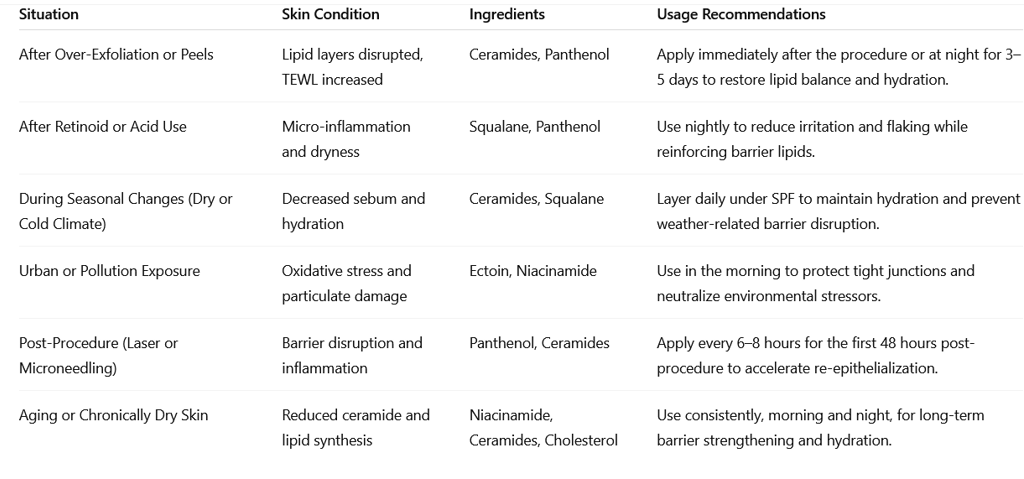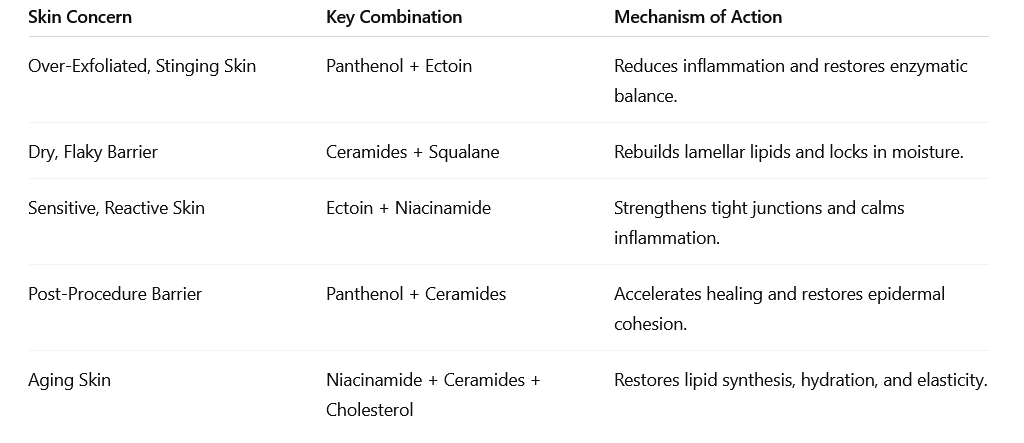
Barrier-Loving Ingredients You Should Actually Care About
4 min read
Note: The content provided by Cordeo is for informational and educational purposes only and does not constitute medical advice, diagnosis or treatment. Always consult a qualified health provider for advice regarding your specific medical condition. [See Full Disclaimer]
Let’s face it—skincare marketing can make anything sound “barrier-restoring.” But not every trendy ingredient deserves that label. When it comes to actually repairing and protecting your skin’s natural defense system, only a handful of ingredients have solid, research-backed evidence behind them.
These are the true barrier-loving molecules your skin knows how to use—those that rebuild structure, calm inflammation, and balance hydration. Here’s how they work, what the science says, and when to use them effectively.
THE INGREDIENTS
1. Ceramides: The Structural Architects of the Skin Barrier
Ceramides are the true building blocks of your skin’s “mortar.” They are sphingolipids that make up nearly 50% of the stratum corneum’s lipids [1].
They form lamellar layers between corneocytes, sealing in moisture and preventing transepidermal water loss (TEWL). When your barrier is damaged—due to harsh cleansers, over-exfoliation, or aging—ceramide levels drop dramatically [2].
Replacing them topically, ideally in a 3:1:1 ratio of ceramides, cholesterol, and fatty acids, helps restore the barrier more efficiently [3].
Clinical tip: Pair ceramides with niacinamide, which boosts your skin’s own ceramide synthesis [4].
2. Squalane: The Natural Replenisher
Squalane, the stable hydrogenated form of squalene, is one of the most biocompatible emollients found in skincare. Naturally present in human sebum, it restores suppleness and creates a breathable occlusive layer that prevents moisture loss.
It also protects lipids from oxidation caused by UV exposure or environmental pollutants [5].
Clinical tip: Squalane is excellent as the final layer at night—it seals in hydration and prevents overnight water loss, especially in dry or retinoid-treated skin.
3. Panthenol: The Soothing Humectant
Panthenol (Pro-vitamin B5) acts as both a humectant and a barrier repair agent. It is converted into pantothenic acid in the skin, a component of coenzyme A that plays a crucial role in lipid synthesis and barrier restoration.
It improves hydration, reduces inflammation, and accelerates wound healing by supporting fibroblast activity [6].
Clinical tip: Use panthenol-based creams after dermatological procedures such as microneedling, peels, or laser treatments to support healing and reduce irritation.
4. Ectoin: The Cellular Protector
Ectoin is a natural extremolyte—an adaptive molecule produced by microorganisms living in extreme environments such as salt lakes and deserts. In skincare, it forms a protective hydration shell around cells, shielding them from oxidative stress and maintaining protein stability [7].
Ectoin reduces inflammation, enhances tight junction integrity, and improves skin resilience to UV radiation and pollution [8][9].
Clinical tip: Ideal for sensitive, reactive, or pollution-exposed skin. Use daily for protection against oxidative and environmental damage.
5. Niacinamide: The Cellular Strengthener
Niacinamide (Vitamin B3) is a versatile active that supports nearly every layer of the epidermis. It increases ceramide and fatty acid synthesis, improves filaggrin production (essential for natural moisturizing factor), and reduces inflammation [10].
In clinical studies, formulations with 2–5% niacinamide reduced TEWL by up to 27% within eight weeks [11].
Clinical tip: Start with 2–5% concentrations if your barrier is compromised. Higher doses (10% or above) can be irritating until the skin is more resilient.
WHEN AND HOW TO USE THEM?




Understanding when to use barrier-repair ingredients can make the difference between visible improvement and wasted effort. The following guide helps integrate these actives effectively into different situations.


Ingredient Synergy: Building a Stronger Barrier


Barrier-loving ingredients are not passing trends—they are biologically relevant compounds that help the skin restore its own equilibrium.
When you use ingredients your skin naturally recognizes—ceramides, squalane, panthenol, ectoin, and niacinamide—you’re not just applying a moisturizer; you’re helping your skin rebuild itself.
Healthy skin isn’t about perfection—it’s about function, resilience, and calm balance.
REFERENCES
Feingold KR. The role of epidermal lipids in cutaneous permeability barrier homeostasis. Journal of Investigative Dermatology, 2007;127(10):2291–2301.
Elias PM, Choi EH. The role of ceramides in the skin barrier. Dermato-Endocrinology, 2005;1(2):65–69.
Rawlings AV, et al. Skin barrier restoration: the importance of ceramide-cholesterol-free fatty acid ratio. Journal of Lipid Research, 2004;45(3):485–495.
Draelos ZD. Nicotinamide: A multifunctional cosmeceutical ingredient. Dermatologic Surgery, 2019;45(8):1088–1094.
Lodén M, et al. Sebum lipids and the skin barrier. Acta Dermato-Venereologica, 2017;97(7):897–904.
Proksch E, et al. Panthenol in skin disorders and wound healing. Clinical, Cosmetic and Investigational Dermatology, 2018;11:511–519.
Becker K, et al. Ectoine-based skin care for barrier repair and anti-inflammation. Journal of Clinical Medicine, 2021;10(5):1107.
Yuki T, et al. Impaired tight junctions in atopic dermatitis skin and their modulation. PLoS One, 2016;11(9):e0161759.
Grether-Beck S, et al. Ectoin: A natural stress-protection molecule for skin health. Experimental Dermatology, 2018;27(7):773–780.
Hakozaki T, et al. Clinical effects of niacinamide on skin barrier and pigmentation. British Journal of Dermatology, 2002;147(1):20–31.
Draelos ZD. Barrier improvement and TEWL reduction with niacinamide. Cutis, 2019;103(2):107–112.
CORDEO
FOR CONATCT:
© 2025. All rights reserved.
Rooted in science. Built with integrity. Designed to empower.
HOME
ABOUT
THE HEALTH EDIT
SKIN BY CORDEO
NOURISH BY CORDEO
MED JOURNAL
CORDEO SHOP
THE HEALTH ORBIT
CORDEO LETTER
THE DIGITAL HUB
CORDEO CONSULTS
CONTACT US
COMING SOON
Cordeo is a digital wellness platform that offers medically-informed content and curated tools for holistic health. The content on this site is for informational and educational purposes only and does not constitute professional medical advice, diagnosis, or treatment. Always consult a qualified healthcare provider for personalized medical guidance.
By using this website, you acknowledge and agree to our Disclaimer, Privacy Policy, Terms & Conditions, Cookie Policy, Editorial Policy, and User Conduct Agreement.
Affiliate & Sponsorship Notice: Some content may include affiliate links, and we may earn a commission on qualifying purchases — at no extra cost to you. We do not process refunds for affiliate partner products or services.
For comprehensive legal and compliance information, please visit our legal and policy center.
This site is governed by the applicable laws of India.
© 2025 Cordeo. All rights reserved. | This site is for informational and educational purposes only and does not constitute professional medical advice.
📢 Cookie & Data Use Notice
We use cookies and similar technologies to enhance your browsing experience, analyze site traffic, and personalize content. By continuing to use this site, you agree to our use of cookies in accordance with our Cookie Policy.
You can manage your preferences or opt-out of non-essential cookies anytime.